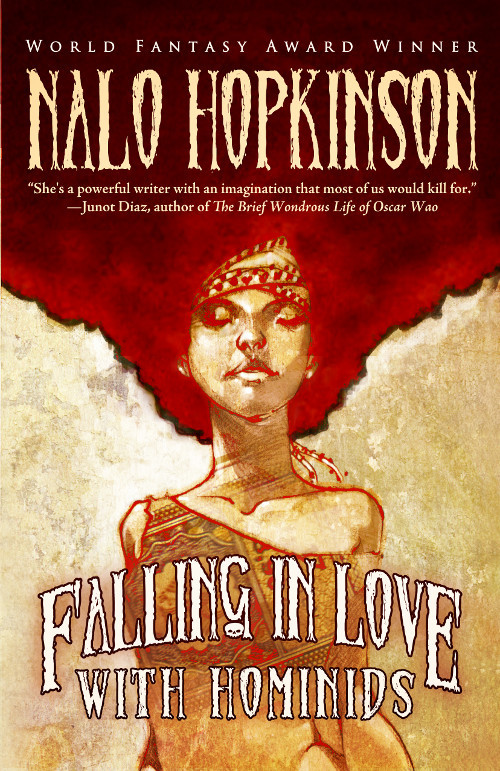The engaging FALLING IN LOVE WITH HOMINIDS is triumphant

In the August, 2015 issue of THE NEW YORK REVIEW OF SCIENCE FICTION, Sandra Lindow and Callista McRae each deliver a separate review of Nalo Hopkinson’s brilliantly envisioned FALLING IN LOVE WITH HOMINIDS.
Callista McRae:
Hopkinson’s sense of humor and her dazzling imagination hold this variegated collection together. (Its stories were written over the last dozen or so years and were published in a wide range of places—as collaborations, in anthologies of dystopic fiction or gay-themed horror, in a literary magazine volume devoted to new wave fabulists.) Humor also seems to spark the imagination of these stories at times.
<snip>
The collection moves all over. One story has not only aliens but talking animals, from a “moving carpet of snails and slugs” to cassowary, oryx, and crake. The story that follows it, however, enacts how trauma, even when pressed to the back of one’s mind, keeps intruding in one’s periphery; if the story is fantastical at all, it is in that mind.
Where Hopkinson’s wit, imagination, and social engagement fuse is in her prose, which bears out that standard written English is not the only or best container for science fiction. The linguistic invention in this collection isn’t as
constant or far-reaching as it was in the carnivalesque Midnight Robber (2000), which was told in varying degrees of a hybrid futuristic patois. But Falling in Love with Hominids runs through a scale of brilliantly envisioned and carried-out verbal play, often with Afro-Caribbean language.
<snip>
The scope of Hopkinson’s world delights. Simultaneously she reminds us that the actual state of things is often smaller, pettier, more complacent, or more brutal than we think. The disparate nature of this collection itself speaks to these different realms, in different voices and different ways. It’s a hodgepodge, triumphant.

Sandra Lindow:
Nalo Hopkinson is a woman with an agenda. In the foreword to this, her second short story collection, she writes that she “didn’t used to like people much” for the obvious reasons: “evil, unhappiness, violence, and pain.” As a teenager, she believed humanity had spread across “the face of this planet like a fungus, altering and destroying whole ecosystems and species …” and like many ecologically minded teenagers she was “engulfed by despair.” However, she had family, friends, music, and books, positive influences that eventually caused her to consider humanity’s potential for “great good” as well as its “horrifying evil.” Now at “a mostly cheerful fifty-something” she has overcome her early sense of powerlessness to work towards positive change through her writing. In a paraphrase of Cordwainer Smith, she concludes that her life “has been a process of falling in love with hominids.”
The seventeen stories in this collection were written over a ten-year period beginning in 2004 and were initially published in anthologies and small press magazines. Unlike work by other Canadian writers such as Robert J. Sawyer’s Hominids (2003) or Sara Gruen’s Ape House (2010), no story here actually depicts a love relationship with either a prehistoric person or a great ape. Rather, the term “hominid” is carefully chosen to emphasize Homo sapiens’s membership in and connection to both the animal kingdom and the natural world.
<snip>
As in Skin Folk (her first collection, from 2001) and her novels Brown Girl in the Ring (1998), Midnight Robber (2000), and The Salt Roads (2003), the supernatural regularly intersects with the natural, but these tales for the most part begin without the immediate cultural estrangement of the earlier works. The language is colloquial, and the characters accessible, drawing readers into the rhythms of word games, chicken coops, coffee pots, and daily life before taking a quantum shift into the unexpected and surreal.
<snip>
The luminous warmth of these opening lines indicates utopian possibility that stands in opposition to the icy winters of racism, sexism, and homophobia. To fall in love with hominids is the first step in creating a better world. The next step is to envision an eco-friendly community in which this love can be nurtured. As well as cautionary tales, Hopkinson provides hints of utopia-in-progress throughout this engaging collection.
Read the rest of both reviews in the August, 2015 issue of THE NEW YORK REVIEW OF SCIENCE FICTION.
For more information on FALLING IN LOVE WITH HOMINIDS, visit the Tachyon page.
Cover art by Chuma Hill
Design by Elizabeth Story
